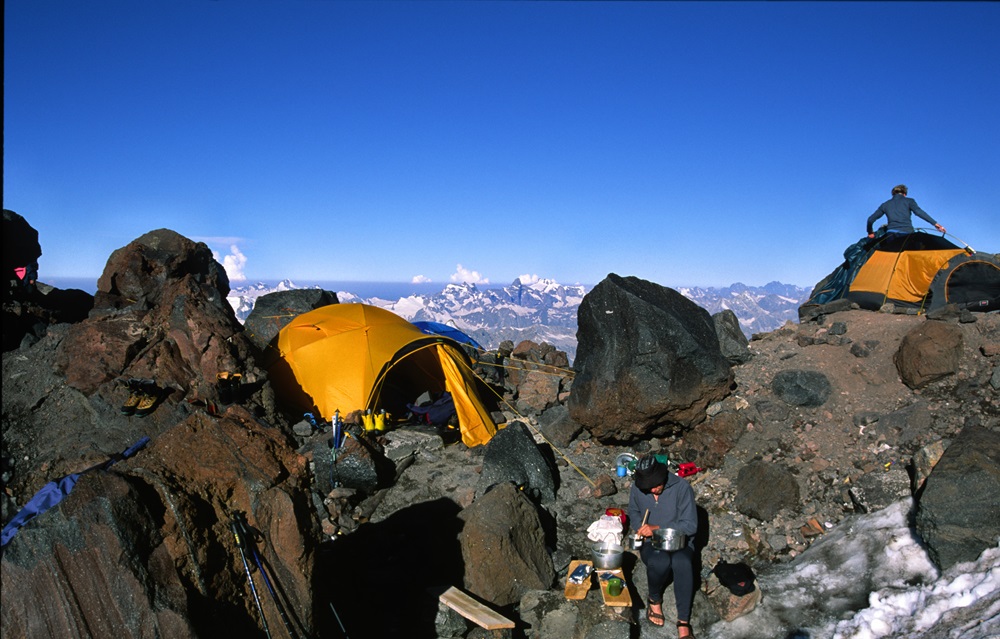Camping in windy weather can be tough, but with the right setup, your ALPS mountaineering tent can stay secure.
Strong winds can damage tents, with gusts over 30 mph risking pole breakage or fabric tears.
This guide shows you how to pitch your tent to handle high winds, keeping you safe and comfortable. Let’s dive into practical steps to make your tent a fortress against the breeze.
Choose the Right Campsite
Picking a good spot is your first step to a stable tent. Look for natural windbreaks like trees, bushes, or hills to shield your tent from gusts.
Avoid open areas like hilltops or beaches, as they’re exposed to stronger winds.
Check for hazards overhead, like dead branches, which can fall in storms. A flat, firm surface helps your stakes grip better, ensuring your tent stays put.
If you’re camping above treeline, find a spot with rocks or low shrubs to block wind.
Data from camping experts suggests that wind speeds can double in open areas compared to sheltered ones. A good site can make all the difference, so take a few minutes to scout before unpacking.
Orient Your Tent for Wind Resistance
Positioning your tent correctly is key to stability. Face the narrowest part of your tent, usually the foot, into the wind to reduce surface area.
This prevents the tent from catching wind like a sail. If the wind shifts, keep the door facing away to avoid gusts blowing inside.
For dome-shaped tents, like many ALPS models, their curved design helps wind flow over smoothly.
Studies show that dome tents can withstand winds up to 40 mph when properly anchored, compared to cabin-style tents that may fail at 25 mph.
Adjust your setup based on the wind direction forecast, which you can check on weather apps before your trip.
Secure Your Tent with Strong Stakes
Stakes are your tent’s anchor in windy conditions. Use sturdy, high-quality stakes, ideally 8-10 inches long, to grip the ground firmly.
Drive them into the soil at a 45-degree angle toward the tent for maximum hold.
In tests, stakes angled this way resist pulling out 50% better than vertical ones. If you’re on loose soil or sand, bury rocks or logs over the stakes for extra security.
For snowy or rocky terrain, consider using snow stakes or ice axes, which can hold up to 2x the force of standard stakes. Always test your stakes with a gentle tug to ensure they’re secure before attaching guylines.
Use Guylines for Extra Stability
Guylines are your secret weapon against wind. These ropes attach to your tent and stakes, spreading tension evenly to prevent flapping or collapse.
Most ALPS tents come with guylines, but you can add more for high winds. Use 3mm non-stretch cords, as they’re less likely to loosen under gusts.
Attach guylines to all available points, especially on the windward side, and tension them tightly.
| Guyline Setup Tips | Why It Helps |
| Use 3mm non-stretch cord | Prevents loosening in gusts |
| Attach to all anchor points | Distributes wind stress evenly |
| Angle guylines at 45 degrees | Maximizes downward force |
Research from mountaineering experts shows that properly tensioned guylines can increase a tent’s wind resistance by up to 30%.
Keep guylines short and close to the ground to maintain downward pressure.
Weigh Down Your Tent
Adding weight inside your tent can keep it grounded. Place heavy items like your backpack, water bottles, or gear bags in the corners once the tent is up.
This prevents the tent from lifting in sudden gusts. For example, a 20-pound backpack can add significant stability, especially in non-freestanding tents.
If you’re solo camping, keep these items ready to toss inside as soon as the poles are set.
In high winds, avoid unpacking the rainfly until the tent body is secure. A loose fly can catch wind and pull stakes out. Once the tent is stable, attach the fly tightly to block wind and rain.
Check and Maintain Your Setup
Wind can loosen stakes and guylines, so check them regularly. Tighten any slack lines and re-drive stakes if they start to lift.
Carry a tent repair kit with patches and duct tape for quick fixes if fabric tears.
Data from outdoor gear tests shows that 60% of tent failures in wind are due to loose stakes or guylines. A quick check every few hours can prevent a midnight collapse.
If rain accompanies the wind, ensure your groundsheet stays inside the tent to avoid collecting water. A sagging tent can let water seep in, so keep guylines taut to maintain shape.

Prepare for Changing Conditions
Wind direction and speed can shift, so stay prepared. Check the weather forecast before your trip and monitor updates.
Winds over 25 mph can break branches, so avoid camping under unstable trees. If conditions worsen, consider delaying your trip or finding a more sheltered site.
For example, the Beaufort Scale rates winds at 25-31 mph as strong breezes, capable of moving small branches.
| Wind Speed (mph) | Beaufort Scale | Potential Impact |
| 25-31 | Strong Breeze | Moves small branches |
| 32-38 | Near Gale | Breaks twigs, risks tent damage |
Having a plan for sudden storms keeps you safe and your tent secure.
Final Tips for a Secure Setup
Setting up your tent for windy conditions takes a bit of planning, but it’s worth it for a safe and comfortable trip.
By choosing a sheltered site, orienting your tent smartly, using strong stakes and guylines, and checking your setup, you can handle gusty weather with confidence.
Always pack a repair kit and extra stakes for unexpected challenges. With these tips, your tent setup will keep you cozy, no matter how hard the wind blows.
Q&A
How much wind can an ALPS mountaineering tent handle?
Answer:
A properly anchored ALPS dome-style tent can withstand winds up to 40 mph, thanks to its curved design that allows wind to flow over smoothly. In contrast, cabin-style tents may start failing around 25 mph due to their less aerodynamic shape.
What’s the best place to pitch a tent in windy conditions?
Answer:
Look for natural windbreaks like hills, trees, or bushes. Avoid exposed areas like hilltops, ridgelines, or beaches, where wind speeds can double. The ideal spot has firm, flat ground and no overhead hazards like dead branches.
How should I orient my tent for maximum wind resistance?
Answer:
Face the narrowest part of the tent (usually the foot end) into the wind to reduce drag. Keep the door away from the wind to avoid gusts blowing inside. Adjust the orientation based on forecasted wind direction.
What kind of stakes work best in high winds?
Answer:
Use 8–10 inch metal stakes and drive them in at a 45-degree angle toward the tent. This angle increases holding power by 50% compared to vertical placement. On loose or snowy ground, add rocks, logs, or snow stakes for extra hold.
How do guylines help in windy conditions?
Answer:
Guylines distribute tension and prevent the tent from collapsing or flapping. Use 3mm non-stretch cord, anchor at a 45-degree angle, and attach to all available guy points, especially on the windward side. This setup can boost wind resistance by up to 30%.
Should I weigh down my tent from the inside?
Answer:
Yes. Placing heavy items like a backpack, water bottles, or gear bags inside the tent adds weight that helps keep it grounded, especially in sudden gusts. A 20-pound pack in each corner adds useful stability.
Should I attach the rainfly before securing the tent?
Answer:
No. In high winds, set up and secure the tent body first. A loose rainfly can catch wind and pull stakes out. Once the tent is stable, attach the fly and tension it to block wind and rain.
What maintenance should I do during a windy night?
Answer:
Check and re-tighten stakes and guylines every few hours, as wind can loosen them. Carry a tent repair kit with duct tape and patches. Most tent failures happen due to loose stakes or guy tension.
What if I’m camping above the treeline?
Answer:
Look for rocks or low shrubs to use as windbreaks. Avoid fully exposed, flat areas. You can bury stakes with rocks to keep them in place or use ice axes/snow stakes for anchoring.









